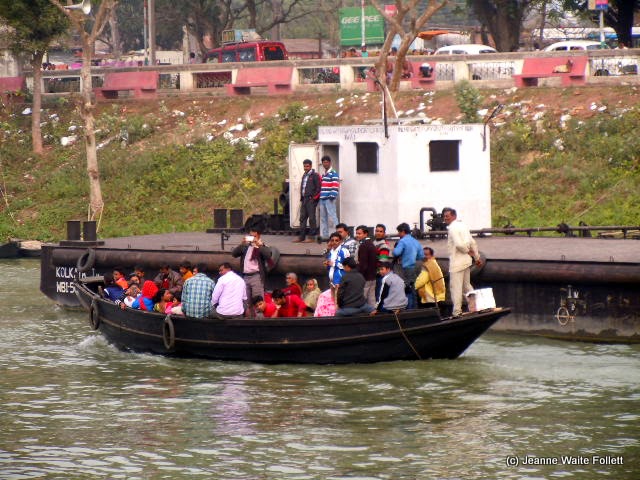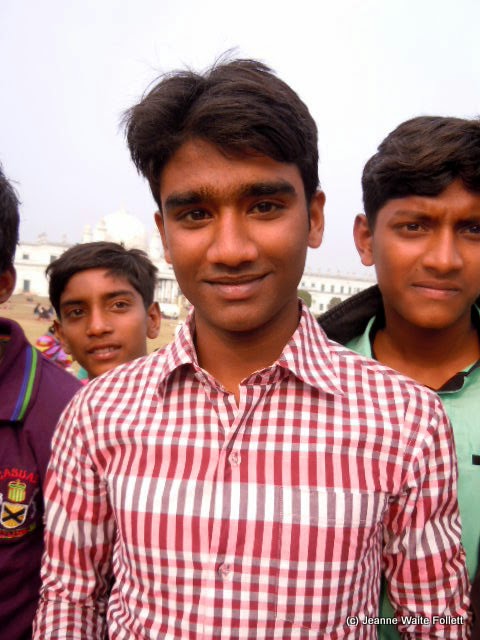Ch. 17, People, People, Everywhere
It's
a dangerous business, Frodo, going out of your door. You step into the road,
and if you don't keep your feet, there is no knowing where you might be swept
off to. - Bilbo Baggins
India is a crowd,
if I may paraphrase the opening sentence of India,
A Million Mutinies Now by V.S.
Naipaul. In his version of that
declarative sentence, he referred specifically to Bombay (Mumbai). With 1.2
billion people, India is rapidly approaching China’s enormous population of 1.3 billion and counting.
 |
| Turning the boat around. |
 |
| And heading up another branch of the river. |
China encompasses 3.7
million square miles if we include its occupied territory of Tibet, while
India’s population is squashed within its 1.2 million square miles, a third the
area. None of the villages, towns, or
cities we visited along the Hooghli/Ganges is considered significant enough to be identified
on the map given to us by Vantage tours, yet one had 40,000 people living there
and another had more than 400,000.
But let me paraphrase
Naipaul again: Murshidabad is a crowd!
 |
| Attracting a crowd at Murshivadat. Yes, that's trash. |
For the first time in
this Ganges discovery voyage, we are to disembark on a proper dock without
need of being ferried to shore by the country boat. There is a problem, though, and a half dozen
men confer about how to solve it.
 |
| A nauka departs the jetty ahead of our docking. |
 |
| Getting off the boat is solved with a two-step arrangement. |
During their time of consternation, I survey the scene on shore, accompanied
by music from a loudspeaker that rightfully is called a “loud-“speaker.
My attention turns to a row of pink benches that line the waterfront. On the first bench are a man and woman.
The second bench has three men.
 |
| Two men sit on the third bench. |
 |
| And a goat has the fourth bench to itself. |
Stepping from the ship
to the dock is a problem quickly solved with a two-step stairs, but the bigger
problem is a rather large step down from the floating dock to the ramp leading
up to the top of the river bank. The
consternation goes on for some time beneath my balcony, all of which I am
enjoying immensely. Another two-step
stairs is fetched from somewhere off stage, and seemingly the problem is
solved.
Until the first tourist
steps off the ship, that is. The first
two-stepper is fine; the second two-stepper, not so much. It seems the plywood of the top step extends
beyond the framework on one side, making the whole thing rather inclined to
fall off on the cantilevered side. A
dock man solves that by pointing where we are to step and placing his foot on
the forbidden, cantilevered side. (That
ankle/neck breaker has disappeared by the time we return. Instead we simply use a round davit as a step stool.)
Then it’s a simple half-giant step up onto the ramp itself and we pass into a loud and colorful
chaos. These are holidays, explains Asif, and many India tourists come for a few days.
The narrow riverbank
road is lined on both sides with bazaar stalls, all a riot of flamboyant colors
and strange products, through which pass men, women, children, goats, bicycles,
rickshaw both manual and gas-powered, pony carriages, and all manner of
vehicles large and small (all of which are beeping their horns). Our guides are kept busy gently ushering us
out of the way of whatever has the right of way over pedestrians and that
appears to be everything.
The people here are
much more open about their curiosity, often coming right up to us to
stare. If we smile and wave, though, we
are met with smiles and waves.
The attention increases as we
reach the grounds of the former British Colonial palace and, across the greens,
the longest imambara (also known as a madrasa—a Muslim religious school) in
India.
Swarms of Indians surge towards the Hazarduari Palace, which is now a museum, as we wait for all our group to escape the bazaar and assemble on the grass. The palace was built and designed under the supervision of British Colonel Duncan MacLeod of the Bengal Corps of Engineers. Construction began in 1829 and was completed in 1839. It was used as a residence for high British officers.
Swarms of Indians surge towards the Hazarduari Palace, which is now a museum, as we wait for all our group to escape the bazaar and assemble on the grass. The palace was built and designed under the supervision of British Colonel Duncan MacLeod of the Bengal Corps of Engineers. Construction began in 1829 and was completed in 1839. It was used as a residence for high British officers.
I sit on a bench and am
immediately accosted by a hawker asking 100 rupees (about $2) for a packet of postcards. I say no.
He says 100 rupees and places the packet in my lap. I give it back; he replaces it. This exchange is repeated several times
before I stand up and retreat to Asif, where I ask him to please tell the
hawker I do not want to buy the postcards.
That works.
At least the chai
vendor takes no for an answer and
walks away.
After that, I am accosted by more pleasant people who want to take my picture and have their picture taken with me. There are so many of them that fellow traveler Linda says, "You were the feature attraction." I take note of that. It did seem that way, and I wonder why.
After that, I am accosted by more pleasant people who want to take my picture and have their picture taken with me. There are so many of them that fellow traveler Linda says, "You were the feature attraction." I take note of that. It did seem that way, and I wonder why.
 |
| Chai for sale |
We leave our
cameras and cell phones with a ship crewman as the items are not allowed in the
museum, and join the swarming
masses. There are close but separate
entrances for men and women and a security check.
The first floor is
lined with displays of weapons, the second with art (including a Van
Dyke). There are 20 galleries in this
museum and I have nowhere near enough time to peruse even a few of them. There is a crush of people in the museum. I often step aside and let a large group pass and as a result, I quickly lose track of my group. I'm not claustrophobic, but I don't do well in masses of people.
Eventually, I escape
the museum crush and head right for my camera, where I am swarmed again, not by
the hawkers, but by the people.
Westerners gawk from a distance; Indians are so close they could put their arm around your
shoulder as they gawk, but they are polite They maneuver to
take photos of us quite openly and delight in us taking photos of them and
showing the results. They return the
favor.
 |
| She's posing. He's not too sure about this. |
 |
| So casual as they observe us. |
Soon they are motioning
for photos—both to have them with us and for us to take theirs. The smallest children stare in wonder,
perhaps tinged with a bit of fear, when I show them their photos.
I see a young man
starting to take a discreet photo of his friend positioned with Westerners
behind him. I photo-bomb the scene and
the photographer smiles and wants his photo taken with me. Soon we have our arms around each other, posing for photos.
For the first time, I understand how it feels to be
a curiosity, and though I try to be courteous and ask for permission before
taking a photo, I vow to be even more considerate.
Or sneakier.
Whatever works.
 |
| It isn't this dark as the sun slips into the constant fog/smog haze, but the camera is catching all the light from the sun and automatically adjusts to it. |


























Loved that the goat had his very own pink bench all to himself! And yes, it does seem like every vehicle of any kind there has a need to honk its horn. Perhaps the consternation with getting from the boat to the floating dock was because you were the first large boat that had docked there. The people ARE, for some reason, fascinated with Westerners, as you have found, to the point of openly staring, at close range. And, smiled and waved at, they almost always respond with great happiness and enthusiasm! Love this trip. Love the people. Love India. Patti in Alaska/Cap in Hong Kong
ReplyDeleteBUT India does NOT have the land mass of China. So the density is greater. The first photo of trash is typical all over India. I was on a tour with high class (caste) well educated professional (employment wise) India residents and they casually tossed food and paper plates hither and yon with no abashment whatsoever. I could not deal with it or with them and their cavalier attitude of .. so what .. who cares! Noise pollution all over India is common.
ReplyDeleteLove it .. Immaculate births .. premature .. LOVE IT .. wonderful .. India at its finest .. So too is the last photo .. SO TOO is the last photo so typical of India .. the sun and the air (pollution? NO .. In India .. NO ) ..
You are seeing some of the real India. Good Tour Management.
Smiles from Cap in Hong Kong and Patti in Anchorage .. LOVING YOUR TRIP ..
My lovely comment vanished when I posted it. And it was so, so lovely. Ha Ha.
ReplyDeleteAnyway, my biggest point was why don't they pick up the trash??
Lord I too just lost a long comment I put up here .. Where does it end? When does it get easy? Answer : NEVER ..
DeleteShaddy it is a cultural thing .. it is a class thing .. it is a caste thing .. to pick up trash would be BELOW them! I hate it becaise it is horrible and diseases spread from the trash as it rots and spoils and emits foul odors. It it in the North and in the South.. It is in the East and in the West .. it is all over India ..
Smiles .. Cap ..